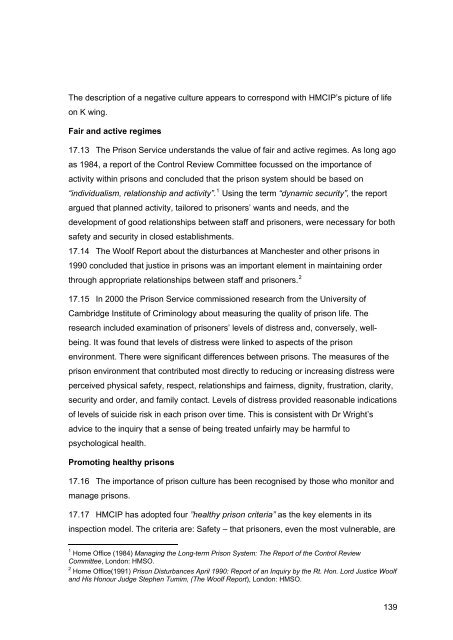Report of the Inquiry into the circumstances of the Death of Bernard ...
Report of the Inquiry into the circumstances of the Death of Bernard ...
Report of the Inquiry into the circumstances of the Death of Bernard ...
Create successful ePaper yourself
Turn your PDF publications into a flip-book with our unique Google optimized e-Paper software.
The description <strong>of</strong> a negative culture appears to correspond with HMCIP’s picture <strong>of</strong> life<br />
on K wing.<br />
Fair and active regimes<br />
17.13 The Prison Service understands <strong>the</strong> value <strong>of</strong> fair and active regimes. As long ago<br />
as 1984, a report <strong>of</strong> <strong>the</strong> Control Review Committee focussed on <strong>the</strong> importance <strong>of</strong><br />
activity within prisons and concluded that <strong>the</strong> prison system should be based on<br />
“individualism, relationship and activity”. 1 Using <strong>the</strong> term “dynamic security”, <strong>the</strong> report<br />
argued that planned activity, tailored to prisoners’ wants and needs, and <strong>the</strong><br />
development <strong>of</strong> good relationships between staff and prisoners, were necessary for both<br />
safety and security in closed establishments.<br />
17.14 The Woolf <strong>Report</strong> about <strong>the</strong> disturbances at Manchester and o<strong>the</strong>r prisons in<br />
1990 concluded that justice in prisons was an important element in maintaining order<br />
through appropriate relationships between staff and prisoners. 2<br />
17.15 In 2000 <strong>the</strong> Prison Service commissioned research from <strong>the</strong> University <strong>of</strong><br />
Cambridge Institute <strong>of</strong> Criminology about measuring <strong>the</strong> quality <strong>of</strong> prison life. The<br />
research included examination <strong>of</strong> prisoners’ levels <strong>of</strong> distress and, conversely, wellbeing.<br />
It was found that levels <strong>of</strong> distress were linked to aspects <strong>of</strong> <strong>the</strong> prison<br />
environment. There were significant differences between prisons. The measures <strong>of</strong> <strong>the</strong><br />
prison environment that contributed most directly to reducing or increasing distress were<br />
perceived physical safety, respect, relationships and fairness, dignity, frustration, clarity,<br />
security and order, and family contact. Levels <strong>of</strong> distress provided reasonable indications<br />
<strong>of</strong> levels <strong>of</strong> suicide risk in each prison over time. This is consistent with Dr Wright’s<br />
advice to <strong>the</strong> inquiry that a sense <strong>of</strong> being treated unfairly may be harmful to<br />
psychological health.<br />
Promoting healthy prisons<br />
17.16 The importance <strong>of</strong> prison culture has been recognised by those who monitor and<br />
manage prisons.<br />
17.17 HMCIP has adopted four ”healthy prison criteria” as <strong>the</strong> key elements in its<br />
inspection model. The criteria are: Safety – that prisoners, even <strong>the</strong> most vulnerable, are<br />
1<br />
Home Office (1984) Managing <strong>the</strong> Long-term Prison System: The <strong>Report</strong> <strong>of</strong> <strong>the</strong> Control Review<br />
Committee, London: HMSO.<br />
2<br />
Home Office(1991) Prison Disturbances April 1990: <strong>Report</strong> <strong>of</strong> an <strong>Inquiry</strong> by <strong>the</strong> Rt. Hon. Lord Justice Woolf<br />
and His Honour Judge Stephen Tumim, (The Woolf <strong>Report</strong>), London: HMSO.<br />
139
















